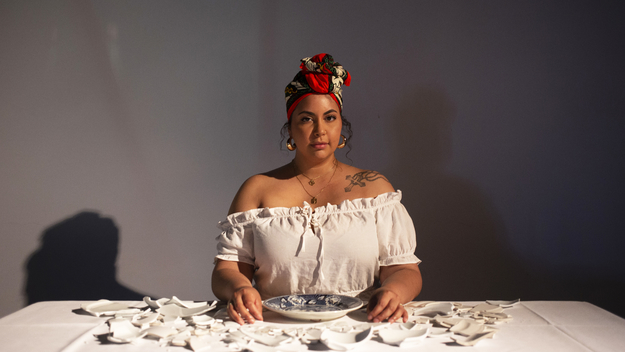Can you tell me about your journey becoming a spoken word poet and artist?
I never formally studied writing. I discovered a love of writing through the hip hop era of meaningful lyricism while I was living in the US, when I was around 11 or 12 years old. I had a Discman that I’d listen to hip hop, rap and R&B, and write the lyrics in my journal like a diary. From there, I started writing for the love of it, and I had the chance to study advanced literature and poetry at a young age. Being from an immigrant family, when we moved to the Netherlands, I didn’t consider studying literature or the creative arts. There was “no time for reading or art”, and it was important to help out the family where you could. I actually began to study law, and up until recently was working in the more corporate world before finally deciding to pursue writing and art full-time.
What is your creative process like writing for an event series like Code Noir?
Because of how I came to be in art now, it’s so important for me to write about the journey that brought me here, and to write about my heritage and ancestors. In this, combining languages-- Spanish, Dutch, English, and Papiamento-- became my thing. I write to heal-- healing for my ancestry-- and languages are a really big part of my life. Speaking so many, it can be hard to switch between them, and each serves a different purpose. Spanish is the language spoken at home, and how I describe my emotions and feelings. I dream in English, work in Dutch, and speak Papiamento with my family in Curacao. Even with my work in the Netherlands; if I don’t know how to say it in Dutch, I’ll say it in Spanish. Because I studied law in Dutch, I find it hard to show my soft side authentically; in Dutch I get down to business. Everything in Spanish sounds like a poem; I’m much more dramatic and emotional in Spanish, and there are so many more words and expressions in Spanish-- and English too.
With writing, I express my thoughts and feelings in English, working with metaphors and the senses like taste, touch, and smell to paint a picture. Spanish music, being so colorful and descriptive, helps fill out the pictures of my poetry as well. Metaphors are a big part of being able to write and talk about hard subjects. They’re more inviting to the listener, and playing with a calm voice and pauses, I make you lean in to listen more.
Do you have a favourite line? Or a poem that was difficult to materialize?
For Code Noir, I focused my energy on the European period poem. I was the most worried about it because I wanted to create something memorable that matched with the memorable setting of the course-- with the broken plates along the long table, the real, ornate candelabras, and the video of me taking a seat at the table with the guests. I wanted to create an uncomfortable experience-- one where you would actually feel like you were eating me-- but used metaphors to balance out potentially being too harsh. My favourite line is from this European period poem--a play on words:
I have been mixed, stirred, whisked, beaten, and whipped
until there has been nothing left of me to hold onto.
In general, I create poetry you’re leaning into, and while you think you’re reading about food, you realize through metaphors that I’m inviting you to think about a more uncomfortable topic. For Code Noir, and especially this poem, you have this realization as you’re hearing it-- that I’m using cooking words to indicate the countless stories of the ingredients and people behind the meal. A lot of people don’t realize that they’re eating something created or born out of not only pain, but also strength.
Western eating is dominated by ignorance, and blind or blissful unknowing. I find consumption without intention frustrating, and that frustration is in the poem along with the stories in me-- you are consuming that. You can’t eat and leave, and not think about it. Many people don’t have to acknowledge the stories of the dishes born out of survival. But collectively, we prepare dishes and we all are still doing rituals-- each person in a family or community is involved in the preparation and eating together. Eating certain dishes to me feels like victory.
What do you hope for the future of Code Noir?
Everyone has the right to experience this. I want to dive deeper into the food and poetry, making the experience accessible for all. Representation is important, and if other cultures could use the format of Code Noir to open up conversations about embracing their heritage with pride-- especially Caribbean people-- I’d want Code Noir to bring people together to share stories. To create an experience where you enter a different world, beginning to end, and are educated while coming together. Food is life!
For more of Rachel’s poetry from Code Noir, check out the links below.
